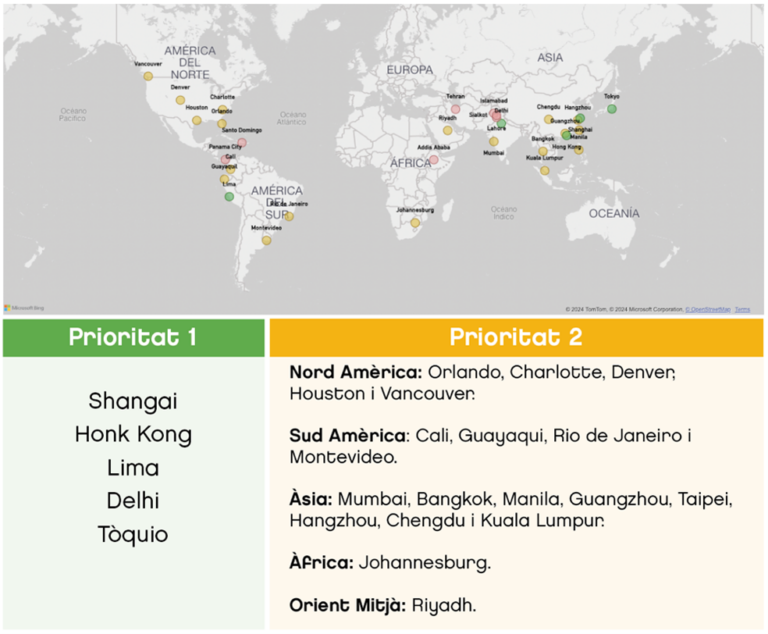- The BARDC's new Strategic Plan for the period 2024-2025 pursues a threefold objective: to prioritise routes not served in Asia and Latin America, to recover some pending post-COVID routes, and to increase frequencies and minimise seasonality on existing routes.
- The BARDC's activity has helped the airport to triple the number of intercontinental destinations in the last 19 years (from 17 to 50), and to recover almost all the routes lost due to the pandemic.
Barcelona, 20 February 2024 – Increasing connectivity, recovering routes, and improving their quality. This is the triple aim set by the Barcelona Air Routes Development Committee (BARDC) for the period 2024-2025, which was presented today at a press conference at La Llotja de Mar. This was explained by the Secretary of Mobility and Infrastructures of the Department of Territory of the Government of Catalonia and President of the BARDC, Marc Sanglas i Alcantarilla; the Commissioner for International Relations and City Promotion of Barcelona City Council, Pau Solanilla; the Director of Josep Tarradellas Barcelona-El Prat Airport, Eva Valenzuela; and the President of the Barcelona Chamber of Commerce, Josep Santacreu, during their speeches. The four organisations behind the CDRA once again expressed their commitment to continue to achieve one of the organisation's founding objectives: to promote intercontinental flights from the Catalan capital's airport. In this regard, during the presentation it was made clear that although in 2023 the airport recovered most of the priority connections with the opening of the Asian countries, it is now entering a new phase focused on opening new markets and greater frequencies. For this reason, the objectives of the Strategic Plan have been substantially revised to respond to the post-COVID reality of the aviation sector and the global challenges it faces. Specifically, the new Strategic Plan for the period 2024-2025 is a comprehensive review of all major destinations: those not served and the destinations that are already served but need improving; a programme that will act as the BARDC's action plan. In fact, for the routes not yet served, the BARDC has identified two categories, as shown in the figure below. The highest priority, the world’s great metropolises in terms of competitiveness and international influence, with high demand with Barcelona, some of which were operated in 2019 and have not yet been recovered. In this vein, Shanghai, Hong Kong, Lima, Delhi, and Tokyo have become the most strategic priority markets. At the same time, other destinations have also been identified and categorised as Priority 2, following the same criteria. The plan presented has also analysed the routes already in operation but which could be improved in terms of quality of supply, considering the high passenger demand. In this respect, priority has been given to seasonal routes, with the aim of deseasonalising them (e.g. San Francisco, Chicago, and Washington DC); as well as other routes which, although operated all year round, have few frequencies and therefore need improving (Santiago, Buenos Aires, Beijing, Singapore, among others). The aim with these destinations is to increase the number of frequencies throughout the year, reducing seasonality as much as possible, to make them more attractive to business passengers. It should be borne in mind that because of the BARDC's activity, several airlines have made a commitment to Barcelona and have begun to operate new intercontinental flights in recent years with an increase in frequencies in order to generate greater attraction for business passengers and contribute to the economic development of Barcelona and Catalonia. Specifically, for the current year, JT Barcelona-El Prat Airport is expected to recover the route to Hong Kong (Cathay Pacific) and obtain new intercontinental links to Dallas (American Airlines), Miami (LEVEL), and San Francisco (United Airlines). Existing routes will also be consolidated, such as Delta Airlines' additional daily frequency to New York and Qatar Airways' third daily frequency to Doha. In fact, the confirmation – by Level – of having obtained the airline operating certificate makes the airport of key importance for the development of new long-haul destinations and the ability to generate connecting traffic through the Vueling agreements. Thus, there will be three regular airlines – Volotea, Vueling, and Level – with headquarters in Barcelona, providing great added value in terms of industry and knowledge. Balance of the BARDC Strategic Plan in the period 2020-2024 During the period of the 2020-2024 Strategic Plan, 17 new strategic destinations and/or routes have been opened, such as Shenzhen (Shenzhen Airlines), Calgary (WestJet), Chicago (United Airlines) and Jeddah (Saudia Airlines), among others. In addition, the number of destinations has tripled in the last 19 years (from 17 to 50) and almost all the routes lost to the pandemic have been recovered. In this sense, the activity of the Barcelona Air Routes Development Committee (BARDC) has contributed to the fact that, in 2023, Josep Tarradellas Barcelona-El Prat Airport transported 7.64 million intercontinental passengers – considering direct (3.20 million) and indirect (4.44 million) passengers. This positive balance is the result of the new routes and frequencies that have been created thanks to the Committee's initiatives. Specifically, over the last year, JT Barcelona-El Prat Airport operated an average of 276 weekly intercontinental frequencies, approaching the 304 of 2019, as well as providing an offer of 6.93 million seats. This figure is significantly higher than in 2022, when 5.48 million seats were offered (+26% in relative terms), but still significantly lower than in 2019, when 7.83 million seats were recorded. In terms of demand, total intercontinental air traffic in 2023 grew by 5.5 million passengers compared to 2020 (the worst year of the pandemic), owing to a +195% increase in direct intercontinental traffic and a +228% boost in indirect intercontinental traffic. These results highlight the work carried out jointly by the four institutions that make up the BARDC to promote the growth of intercontinental demand for Barcelona, but they also demonstrate that the work carried out by the BARDC is still necessary. The BARDC is the result of the collaboration that arose in 2005 between the Government of Catalonia, Aena, Barcelona City Council, and the Barcelona Chamber of Commerce. A commitment to institutional collaboration that seeks to promote the city of Barcelona, achieve more direct intercontinental connections, and boost the city as an economic and tourism driver. Source: #BARDC #GPA CATALAN VERSION
Shanghai, Hong Kong, Lima, Delhi i Tòquio, els mercats prioritaris per incrementar el tràfic intercontinental de l’Aeroport Josep Tarradellas Barcelona - El Prat
- El nou Pla Estratègic del CDRA per al període 2024-2025 persegueix un objectiu triple: prioritzar rutes no servides a l’Àsia i Llatinoamèrica, recuperar algunes rutes pendents postcovid i l’increment de freqüències i la minimització de l’estacionalitat a les rutes ja existents.
- L’activitat del CDRA ha contribuït a fer que en els darrers 19 anys l’aeroport hagi triplicat el nombre de destinacions intercontinentals (17 a 50), i que s’hagin recuperat gairebé la totalitat de les rutes perdudes per la pandèmia.
Barcelona, 20 de febrer de 2024.- Incrementar la connectivitat, recuperar rutes i millorar-ne la qualitat. Aquest és el triple objectiu que s’ha marcat el Comitè de Desenvolupament de Rutes Aèries de Barcelona (CDRA) per al període 2024-2025 i que s’ha presentat avui en roda de premsa a La Llotja de Mar. Així ho han detallat el secretari de Mobilitat i Infraestructures del departament de Territori de la Generalitat de Catalunya i president del CDRA, Marc Sanglas i Alcantarilla; el comissionat de Relacions Internacionals i Promoció de Ciutat de l'Ajuntament de Barcelona, Pau Solanilla; la directora de l’Aeroport de Josep Tarradellas Barcelona – El Prat, Eva Valenzuela, i el president de la Cambra de Comerç de Barcelona, Josep Santacreu, durant els seus parlaments. Les quatre entitats impulsores del CDRA han manifestat una vegada més el compromís per continuar complint un dels objectius fundacionals de l’entitat: impulsar els vols intercontinentals des de l’aeroport de la capital catalana. En aquest sentit, durant la presentació s’ha fet palès que si bé l’any 2023 l’aeroport va recuperar la majoria de les connexions prioritàries amb l’obertura dels països asiàtics, ara s’entra en una nova fase focalitzada en l’obertura de nous mercats i més freqüències. Per aquest motiu, s’ha dut a terme una revisió substancial dels objectius del Pla Estratègic per respondre a la realitat post-COVID del sector de l'aviació i als reptes globals que afronta. En concret, el nou Pla Estratègic pel període 2024-2025 és un estudi exhaustiu de totes les destinacions importants: de les no servides i les destinacions que ja es cobreixen però que caldria millorar; un programa que actuarà com a pla d’acció del CDRA. De fet, per aquelles rutes encara no servides actualment, el CDRA ha identificat dues categories, tal com mostra la figura a continuació. La més prioritària, les grans metròpolis mundials en termes de competitivitat i influència internacional, amb una gran demanda amb Barcelona, i algunes de les quals s’operaven el 2019 i encara no s’han recuperat. En aquest sentit, Shanghai, Hong Kong, Lima, Delhi i Tòquio esdevenen els mercats més prioritaris i estratègics. Paral·lelament, també s’han identificat i categoritzat altres destinacions amb prioritat 2, seguint els mateixos criteris. El pla presentat també ha analitzat aquelles rutes ja operades actualment, però que podrien millorar-se en termes de qualitat de l’oferta, tenint en compte la gran demanda de passatgers existent. En aquest sentit, s’han prioritzat rutes estacionals, amb l’objectiu de desestacionalitzar-les (per exemple San Francisco, Chicago o Washington DC), així com altres rutes que, tot i ser operades durant tot l’any, tenen poques freqüències i, per tant, objecte de millora (Santiago, Buenos Aires, Beijing, Singapur, entre d’altres). La voluntat amb aquestes destinacions és incrementar el nombre de freqüències durant tot l’any, reduint al màxim la seva estacionalitat, per fer-les més atractives pels passatgers de negocis. Cal tenir en compte que fruit de l’activitat del CDRA, diverses companyies aèries han apostat per Barcelona i han començat a operar nous vols intercontinentals durant els darrers anys amb un increment de les freqüències amb l’objectiu de generar més atracció pels passatgers de negocis i contribuir al desenvolupament econòmic de Barcelona i Catalunya. En concret, per a l’any en curs, es preveu que l’Aeroport JT Barcelona -El Prat recuperi la ruta a Hong Kong (Cathay Pacific) i aconsegueixi nous enllaços intercontinentals com el de Dallas (American Airlines), Miami (LEVEL) o el de San Francisco (United Airlines). També es consolidaran rutes existents, com la freqüència diària addicional a Nova York de Delta Airlines o la tercera freqüència diària de Qatar Airways a Doha. De fet, la confirmació -per part de Level- de l’obtenció del certificat operatiu de companyia aèria atribueix a l’aeroport una importància clau pel desenvolupament de noves destinacions de llarg radi i la capacitat de generar trànsit de connexió gràcies als acords de Vueling. Així doncs, seran 3 les companyies regulars – Volotea, Vueling i Level- amb oficines centrals a Barcelona les quals aporten un gran valor afegit industrial i de coneixement. Balanç del Pla Estratègic del CDRA en el període 2020-2024 Durant el període del Pla Estratègic 2020-2024 s’han inaugurat 17 noves destinacions i/o rutes estratègiques, com per exemple, Shenzhen (Shenzhen Airlines), Calgary (WestJet), Chicago (United Airlines) i Jeddah (Saudia Airlines), entre d’altres. A més, en els darrers 19 anys s’ha triplicat el nombre de destinacions (de 17 a 50), així com recuperat gairebé la totalitat de les rutes perdudes per la pandèmia. En aquest sentit, l’activitat del Comitè de Desenvolupament de Rutes Aèries (CDRA) ha contribuït que, durant l’any 2023, l’aeroport de Josep Tarradellas Barcelona – El Prat transportés 7,64 milions de passatgers intercontinentals —considerant passatgers directes (3,20 milions) i indirectes (4,44 milions). Un balanç positiu que és fruit de les noves rutes i freqüències que s’han creat gràcies a les iniciatives del Comitè. Concretament, al llarg del darrer any, l’Aeroport JT Barcelona – El Prat va operar un mitjana de 276 freqüències setmanals intercontinentals, apropant-se a les 304 de l’any 2019, així com una oferta de 6,93 milions de seients. Una xifra notablement superior a la del 2022, quan es van oferir 5,48 milions de seients (un +26% en termes relatius), però encara sensiblement inferior a l’assolida el 2019, quan es van registrar 7,83 milions de seients. En relació amb la demanda, el tràfic aeri intercontinental total l’any 2023 va créixer en 5,5 milions de passatgers respecte al 2020 (pitjor any de la pandèmia), gràcies a l’increment del +195% del trànsit intercontinental directe i l’estimulació del +228% del trànsit intercontinental indirecte. Aquests resultats posen en relleu la feina feta de manera conjunta per les quatre institucions que conformen el CDRA per fomentar el creixent de la demanda intercontinental de Barcelona, però també demostra que la feina desenvolupada pel CDRA continua sent necessària. El CDRA és resultat de la col·laboració sorgida l’any 2005 entre la Generalitat de Catalunya, Aena, l’Ajuntament de Barcelona i la Cambra de Comerç de Barcelona. Un compromís de col·laboració institucional que tracta de promocionar la ciutat de Barcelona, aconseguir més connexions intercontinentals directes i impulsar la ciutat com a motor econòmic i turístic. CATALAN EDITION: Source: WWW.BARCELONALINKS.ORG/WWW.GPA.AERO





